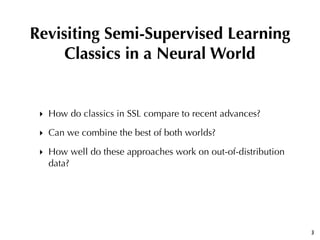Strong Baselines for Neural Semi-supervised Learning under Domain Shift
- 1. Strong Baselines for Neural Semi-supervised Learning under Domain Shift Sebastian Ruder Barbara Plank
- 2. ‣ State-of-the-art domain adaptation approaches ‣ leverage task-specific features ‣ evaluate on proprietary datasets or on a single benchmark ‣ Only compare against weak baselines ‣ Almost none evaluate against approaches from the extensive semi-supervised learning (SSL) literature 2 Learning under Domain Shift
- 3. ‣ How do classics in SSL compare to recent advances? ‣ Can we combine the best of both worlds? ‣ How well do these approaches work on out-of-distribution data? 3 Revisiting Semi-Supervised Learning Classics in a Neural World
- 4. • Self-training • (Co-training) • Tri-training • Tri-training with disagreement Bootstrapping algorithms
- 5. 1. Train model on labeled data. 2. Use confident predictions on unlabeled data as training examples. Repeat. 5 Self-training - Error amplification
- 6. ‣ Calibration ‣ Output probabilities in neural networks are poorly calibrated. ‣ Throttling (Abney, 2007), i.e. selecting the top n highest confidence unlabeled examples works best. ‣ Online learning ‣ Training until convergence on labeled data and then on unlabeled data works best. 6 Self-training variants
- 7. 7 1. Train three models on bootstrapped samples. 2. Use predictions on unlabeled data for third if two agree. y = 1 x y = 1 1 Tri-training Tri-training
- 8. 8 Tri-training Tri-training 1. Train three models on bootstrapped samples. 2. Use predictions on unlabeled data for third if two agree. 3. Final prediction: majority voting Tri-training y = 1y = 1 y = 0 1 x
- 9. Tri-training with disagreement 9 Tri-training with disagreement 1. Train three models on bootstrapped samples. 2. Use predictions on unlabeled data for third if two agree and prediction differs. y = 1 x y = 1 1 y = 0 - 3 independent models
- 10. ‣ Sampling unlabeled data ‣ Producing predictions for all unlabeled examples is expensive ‣ Sample number of unlabeled examples ‣ Confidence thresholding ‣ Not effective for classic approaches, but essential for our method 10 Tri-training hyper-parameters
- 11. 11 y = 1 x y = 1 1 Multi-task tri-training 1. Train one model with 3 objective functions. 2. Use predictions on unlabeled data for third if two agree. Multi-task Tri-training 3. Restrict final layers to use different representations. 4. Train third objective function only on pseudo labeled to bridge domain shift.
- 12. 12 BiLSTM w2 char BiLSTM BiLSTM w1 char BiLSTM BiLSTM w3 char BiLSTM m1 m2 m3 m1 m2 m3 m1 m2 m3 orthogonality constraint (Bousmalis et al., 2016) Multi-task Tri-training Lorth = ∥W⊤ m1 Wm2 ∥2 F L(θ) = − ∑ i ∑ 1,..,n log Pmi (y| ⃗h ) + γLorthLoss: (Plank et al., 2016)
- 13. 13 Data & Tasks Two tasks: Domains: Sentiment analysis on Amazon reviews dataset (Blitzer et al, 2006) POS tagging on SANCL 2012 dataset (Petrov and McDonald, 2012)
- 14. Sentiment Analysis Results Accuracy 75 76.75 78.5 80.25 82 Avg over 4 target domains VFAE* DANN* Asym* Source only Self-training Tri-training Tri-training-Disagr. MT-Tri * result from Saito et al., (2017) 14 ‣ Multi-task tri-training slightly outperforms tri-training, but has higher variance.
- 15. 15 POS Tagging Results Trained on 10% labeled data (WSJ) Accuracy 88.7 88.975 89.25 89.525 89.8 Avg over 5 target domains Source (+embeds) Self-training Tri-training Tri-training-Disagr. MT-Tri ‣ Tri-training with disagreement works best with little data.
- 16. 16 POS Tagging Results * result from Schnabel & Schütze (2014) Trained on full labeled data (WSJ) Accuracy 89 89.75 90.5 91.25 92 Avg over 5 target domains TnT Stanford* Source (+embeds) Tri-training Tri-training-Disagr. MT-Tri ‣ Tri-training works best in the full data setting.
- 17. 17 POS Tagging Analysis Accuracy on out-of-vocabulary (OOV) tokens AccuracyonOOVtokens 50 57.5 65 72.5 80 %OOVtokens 0 2.75 5.5 8.25 11 Answers Emails Newsgroups Reviews Weblogs OOV tokens Src Tri MT-Tri ‣ Classic tri-training works best on OOV tokens. ‣ MT-Tri does worse than source-only baseline on OOV.
- 18. 18 POS accuracy per binned log frequency Accuracydeltavs.src-onlybaseline -0.005 0 0.005 0.009 0.014 0.018 Binned frequency 0 1 2 3 4 5 6 7 8 9 10 11 12 13 14 MT-Tri Tri ‣ Tri-training works best on low-frequency tokens (leftmost bins). POS Tagging Analysis
- 19. 19 POS Tagging Analysis Accuracy on unknown word-tag (UWT) tokens AccuracyonUWTtokens 8 12.5 17 21.5 26 %UWTtokens 0 1 2 3 4 Answers Emails Newsgroups Reviews Weblogs UWT rate Src Tri MT-Tri FLORS* ‣ No bootstrapping method works well on unknown word- tag combinations. ‣ Less lexicalized FLORS approach is superior. very difficult cases * result from Schnabel & Schütze (2014)
- 20. ‣ Classic tri-training works best: outperforms recent state-of-the-art methods for sentiment analysis. ‣ We address the drawback of tri-training (space & time complexity) via the proposed MT-Tri model ‣ MT-Tri works best on sentiment, but not for POS. ‣ Importance of: ‣ Comparing neural methods to classics (strong baselines) ‣ Evaluation on multiple tasks & domains 20 Takeaways Tri-training



















